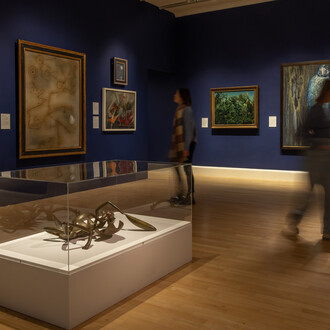A major new exhibition which opens at the Scottish National Gallery of Modern Art is set to explore the remarkable work of Robert MacBryde and Robert Colquhoun. Two of Scotland’s finest twentieth-century artists, their careers rose meteorically in the 1940s when they took the London art-world by storm, but were tragically cut short by an equally dramatic decline in their fortunes, and a subsequent spiral into alcoholism, which ended with their early deaths in the 1960s.
Colquhoun and MacBryde met in 1933 at the Glasgow School of Art, where they were the stars of their generation, marked out from their contemporaries both by their prodigious talent, and the intensity and self-sufficiency of their relationship; they become lovers and worked in close partnership for the rest of their lives. The Two Roberts will be the first major retrospective exhibition devoted to their work, and marks their centenary year.
Both artists came from working-class Ayrshire backgrounds; MacBryde was born in Maybole in December 1913 and Colquhoun in Kilmarnock in December 1914. They moved to London in 1941, where they quickly became part of the celebrated Soho set that included artists such as Francis Bacon and Lucian Freud, and by the mid-1940s, after a string of successful exhibitions, they had become two of the most famous artists working in Britain.
At the beginning of the 1950s however, after a series of setbacks, their success began to tail off, and with sales plummeting and their popular¬ity on the wane, they were caught in a downward spiral. By the end of the decade Colquhoun and MacBryde, whose austere and uneasy paintings so perfectly encapsulate the mood of post-war years, were begging friends for money and sleeping on sofas. Colquhoun died in 1962 at the age of forty-seven, and MacBryde died four years later, aged fifty-three.
This exhibition, which includes over 60 paintings, 70 drawings and monotypes, and a vast array of photographs and archival material, will chart the career of both artists from their days at Glasgow School of Art to the final series of prints which Colquhoun was working on when he collapsed and died, re-establishing them as major forces in post-war British art.








![Yves Tanguy, Le Ruban des excès [The Ribbon of Excess]](http://media.meer.com/attachments/6b83934186c3687eeb36ba7ea0ad8b73c85fb870/store/fill/330/330/332ce244813ee1d8bfbf9b0b5d7fd8bd95b35d47b98747671d199bd15aa1/Yves-Tanguy-Le-Ruban-des-exces-The-Ribbon-of-Excess.jpg)

![Auguste Herbin, Composition (Paysage à Céret) [Composition (Landscape at Céret)]](http://media.meer.com/attachments/74032113600e4e7edef24cd518391ce71672242c/store/fill/330/330/b275d53669ce52b7d92e984c481c9c49d17a6043ea60c4486361539bce8a/Auguste-Herbin-Composition-Paysage-a-Ceret-Composition-Landscape-at-Ceret.jpg)








